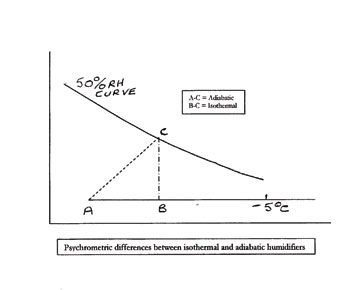There is no single answer to humidification problems,
says Robert Carr, managing director of Carr Marketing, a number of aspects have to be considered in order to achieve the correct
solution
THE object of this article is to concentrate on the use of Adiabatic Humidifiers.
It is important to establish the difference between Adiabatic and Isothermal (steam) humidifiers.
Isothermal humidifiers work on the dry bulb line of the psychometric chart, so the temperature of the treated air does not significantly change. It is a bi-phase action. The heat given up as the steam condenses in the air is re-used in order to evaporate the moisture and absorb it into the airstream.
Adiabatic humidifiers work on the wet bulb line and rely on the heat of the air flow to evaporate the moisture, so there will be a serious temperature drop in the air. Typically, a target figure for fresh air of 21oC and 50%RH in the winter, will require an air on temperature of 34oC. The adiabatic effect will reduce the temperature by 13O in order to evaporate the water being introduced by whatever method.

Psychometric differences between Isothermal and adiabatic humidifiers
The illustration indicates the different positions on the Psychrometric chart for the two methods.
There are a number of different types of adiabatic humidifiers: ultra-sonic, wetted cell, atomiser with compressed air, atomiser with high pressure pump and mechanical atomiser
The ultra-sonic humidifier uses the effect of vibration on a pan of water to atomise the water into an aerosol mist. The power requirement is only 52Watt/hr for each kg of water misted. It is supplied as a complete package with the microprocessor unit built in and the whole unit fits into the ahu. It can accept any control signal to provide excellent proportional control characteristics. These units come as duct or area units and have a comprehensive drain control system to ensure that the water is always clean and fresh. Typically they would be supplied with clean water from a reverse osmosis or de ionised system. This to prevent carry-over of solids from the water.
Maintenance is simple and not expensive. Retro fit is not difficult.
The Airwin NKBD unit can be installed in an ahu or ductwork quite simply.
The wetted cell humidifier is different to the others in that no aerosol or atomising occurs. The water is pumped from a tank at the base to a gallery at the top of the cell matrix and then it is dribbled down to the tank at the base through the cells of the matrix. Air is blowing through the cells of the matrix and it picks up moisture as air would do from the surface of a lake. It is important that the water is treated for sterilisation, so it is normal for an ultra violet lamp to be fitted in the water line from the tank to the gallery. It is sensible to pre-treat the water depending on its hardness. The energy required is only a few hundred watts for the total capacity of the unit. Multi stage control will allow accuracy of ±5% RH or so. Regular maintenance is required for these units.
The desiccant dryair unit comes with the tank and pump and the main structure is all stainless steel.
The atomising types all work in a similar way and all require the same safeguards. They have atomising nozzles or rotors which produces a fog of moisture to the airstream or space.
Moisture eliminators are usually required as there will almost certainly be some carry-over of droplets. The latest type uses a high pressure pump to force water through a fine nozzle at over 90 bar. The power requirement is small. Water treatment is a must. At least softening as well as UV treatment is required.
In an air handling system a number of nozzles or rotors can be installed to meet the capacity. All material must be plastic or stainless steel. Area humidification systems can be achieved but much care must be taken with the location of the nozzles and the method of heating.
Large capacities can be handled by this type, treating significant air volumes. The Swed-Fog system has stainless steel nozzles and manifolds mounted in an air handling unit.
The actual choice depends on a number of factors, the size of the plant, the conditions required, how high is the RH required for example and the amount of money available for the project. Discuss it with a specialist who has all the options available
So what is the point of adiabatic humidifiers?
The low energy requirement is a real benefit.
However, the air must be heated to allow for the temperature drop! What price the saving then?
Well, if there is a cooling problem in the plant and air is being re-circulated, a humidifier that cools may be very welcome. If the supply air is fresh and heated from an air to air heat recovery system, the moisture can be evaporated using the recovered heat.
It may also be that electric power is not available in the amount required for humidification.
If electric power is at a premium, and gas may not be available, adiabatic humidifiers provide a viable, low energy option to steam humidifiers.